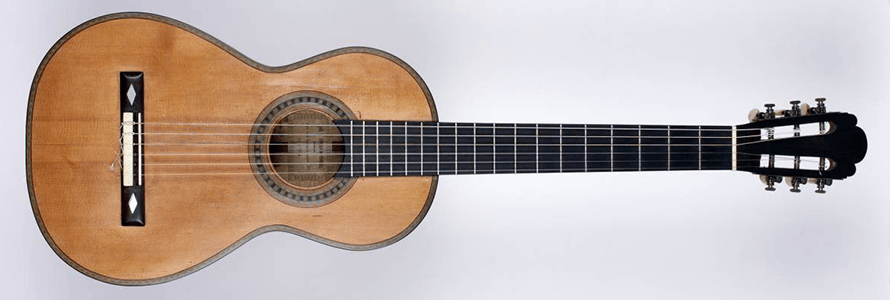Long before the electric guitar shook the world of music in the 20th century, its predecessor, the acoustic guitar, was played by generations upon generations of musicians. With the earliest acoustic guitar traces dating all the way back to the 13th century, the guitar definitely came a long way to reach the shape, form, and status it has today. The acoustic guitar is often somewhat of a vague term, although a lot of people are certain they what exactly it means. In most of the cases, they’re wrong, so stick around as we go through the history of acoustic guitar.
The Earliest Traces of Acoustic Guitar
As previously noted, the earliest examples of stringed instruments similar to modern acoustic guitars can be traced all the way back to the 13th century. However, the definite beginning occurred during the Renaissance cultural era in the 16th century Europe. It was during one of the most artistic periods in the history on mankind that the guitar emerged, rather appropriately most analysts would say.
Initially, the acoustic guitar only had five strings – A, D, G, B, E. It was the later addition of the low E string that finally formed the modern guitar tuning we know today, consisting of low E, A, D, G, B and high E strings. As far as the general look of the guitar is considered, the guitar always had its distinctive rounded body narrowing down in the middle. Of course, standard guitar parts always included a fretted neck, a headstock with a set of tuning heads, a flat back side and a resonator, or the sounding board.
Interestingly enough, the guitar initially had a total of mere eight frets, a number which was subsequently upgraded to ten and then twelve. The number of strings was ultimately also increased to six sometime in the 18th century, bringing the guitar closer to the acoustic axe we all know and love today.
Time Before the Modern Acoustic Guitar
The acoustic guitar had a long way ahead of itself before becoming today’s modern six-string. As previously noted, the addition of the sixth string was one of the crucial steps, generally attributed to German guitar craftsman Joakim Thielke (1641 – 1719). The 18th century marked somewhat of a focus switch when it comes to the acoustic guitar, as the previous century singled out Italy as the very centre of the guitar world. We should also note that the history of acoustic guitar is connected to a great extent with the classical guitar history, seeing that the initial classical guitars belonged to the acoustic guitar family.
Throughout the 18th century, Germany, Netherland and Belgium also started giving their contributions in the acoustic guitar domain, with some of their classical greats producing musical pieces made exclusively for the acoustic, or classical guitar. Several classical guitar composers were significantly acknowledged, bringing the guitar closer to the forefront of the world’s musical scene, where it had ultimately found itself. Such composers include Antoine Marcel Lemoine, Trille Labarre, as well as Santiago de Murcia from Spain, the first guitarist in history who ever used tablatures in his work.
Modern Acoustic Guitar
The production of the very first modern classical acoustic guitar is attributed to Antonio Torres, a Spanish guitarist and luthier, often praised as one of the most important guitar makers in history. Torres constructed the first modern acoustic guitar around the mid-19th century, approximately in the year of 1850. Some of the most crucial adjustments he made consisted of size increase and the invention of the top bracing pattern. The instrument’s volume was therefore improved to a great extent and the same can be said about the entire projection. More importantly, the design of the acoustic guitar has remained basically unchanged to this very day, rightfully earning Mr. Torres all the props and kudos he regularly gets.
One of the aspects of the acoustic guitar of the Torres’ guitar that had become obsolete is the top bracing pattern mentioned beforehand. At the beginning of the 20th century, the steel guitar strings were invented, changing the rules of the game to a solid extent. First and foremost, the tension level was greatly increased, making the top that Torres had produced unable to sustain it. Luckily for the instrument, the X-braced tops were invented in the meantime by German manufacturers, allowing the massive use of steel strings. This brought more loudness for the guitars, and generally a more precise, greater quality sound and tone color.
So although acoustic and classical guitar are closely related, there is still a significant difference between the two. For start, the term classical guitar refers strictly to a particular type of guitar, the original guitar some might say, with a wider neck and wide string width. The classical guitar also comes in relatively smaller size than the standard acoustic guitar and a lighter bracing featured in the interior. The classical guitar also has no truss rod located inside the neck. Several other major differences most definitely stand out.
The acoustic guitar on the other hand, is a much more broad term to begin with. What is often considered as a standard model is an acoustic guitar with a set of steel strings and a thinner neck width. While the classical guitar is focused around the fingerstyle technique, the acoustic guitar is more adapted for playing with a pick, or a plectrum. The neck of the classical guitar also seems shorter, as the frets meet the neck on the twelfth fret, rather than on the fourteenth fret as is the case with the standard acoustic guitar.
Throughout history, the acoustic guitar had its fair share of notable players, most of which helped elevate it towards a higher status. Some of such axeman include the iconic classical guitar player Andres Segovia, legendary jazz guitarist Django Reinhadrt, country guitar hero Chet Atkins, Delta blues master Robert Johnson and Australian sensation Tommy Emmanuel. Young players keep emerging throughout time, keeping the style alive and fresh. As you might already know, most of the electric guitar legend often kicked off their guitar playing with an acoustic model, making it a significant standpoint of their careers.












Add comment